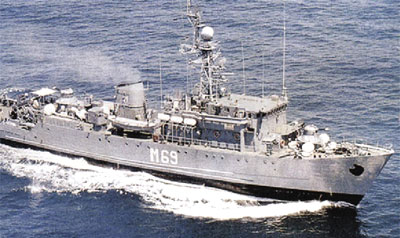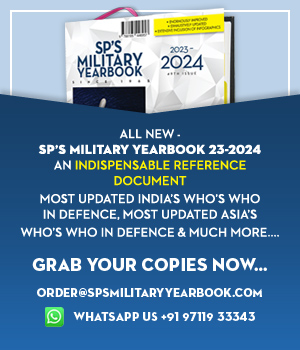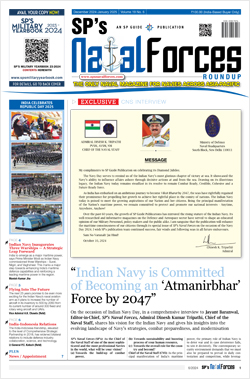INDIAN ARMED FORCES CHIEFS ON OUR RELENTLESS AND FOCUSED PUBLISHING EFFORTS

The insightful articles, inspiring narrations and analytical perspectives presented by the Editorial Team, establish an alluring connect with the reader. My compliments and best wishes to SP Guide Publications.

"Over the past 60 years, the growth of SP Guide Publications has mirrored the rising stature of Indian Navy. Its well-researched and informative magazines on Defence and Aerospace sector have served to shape an educated opinion of our military personnel, policy makers and the public alike. I wish SP's Publication team continued success, fair winds and following seas in all future endeavour!"

Since, its inception in 1964, SP Guide Publications has consistently demonstrated commitment to high-quality journalism in the aerospace and defence sectors, earning a well-deserved reputation as Asia's largest media house in this domain. I wish SP Guide Publications continued success in its pursuit of excellence.
- MoD initiates comprehensive review of Defence Acquisition Procedure 2020, pushes for defence reforms
- G7: The Swansong
- Kalinga Connect: South Asia to Polynesia
- Advanced MRSAM for India for a greater firepower
- Must Credit DRDO for Operation Sindoor, now what is next for defence R&D?
- Operation Sindoor | Day 2 DGMOs Briefing
- Operation Sindoor: Resolute yet Restrained
Technology
Can India cope with a Sea Mine Threat or does India need to act now?

The Indian Navy at present has just 12 Mine Sweeper Ocean (MSO, PONDICHERI class) and 2 Mine Sweeper Inshore (MSI, MAHE class) vessels to safe guard its vast coastline of more than 7500 km, 12 major ports and all the assets within the economic zone.
Can India cope with a Sea Mine Threat or does India need to act now?
The Indian Navy at present has just 12 Mine Sweeper Ocean (MSO, PONDICHERI class) and 2 Mine Sweeper Inshore (MSI, MAHE class) vessels to safe guard its vast coast-line of more than 7500 km, 12 major ports and all the assets within the economic zone.
Since the PONDICHERI class of vessels have almost lived their life, 8 of these vessels are planned to be decommissioned shortly. The remaining 4 MCM vessels are undergoing mid-life refit and also being modernised. On the other hand, the two MAHE class MSI ves-sels have only a limited capability as ocean going vessels and are also aging as well.
Looking into the future requirements of the IN for MCM Vessels, a program for 8 new MCMVs has been initiated. Response from two shipyards were received and currently technical offers are being evaluated by the IN. It is a challenging program, as the first 2 ships would be built abroad and during the same period, the GOA shipyard Ltd. will also be upgraded to be able to build the remaining 6 MCM vessels locally. This upgrade will include infrastructure and training and is part of the requested Transfer of Technology, what has to be offered by the foreign shipyards as well.
Such a challenging program needs time and if everything goes well as planned, the first of class of the new vessels will enter service at the earliest in 4 to 5 years and the last one of these 8 Mine Countermeasure vessels can be expected to join the Navy somewhere in 2021.
Now Considering the foreseen decommis-sioning as well as Mid Life Extension/MLE pro-gram of the MCMV fleet, only 4 PONDICHERI class and about two MAHE class vessels will be available in the inventory of the IN by 2012. If the new MCM vessel program can be realised as scheduled, the MCMVs fleet will start increasing from 2012 but at too slow pace, making them 12 MCMVs in 2021. Therefore, Indian Navy will have a very limited MCM capability from 2012 onward, especially in direct comparison with the coastline of 7500 km and about 12 major ports and all the assets within the economic zone.
Is the mine threat real?
This question nobody realistically can answer, but looking at the past experi-ence, the US NAVY for example has lost or suffered severe damage on more ships by sea mine explosions than by any other reason in the entire period since the sec-ond world war.
Mines are cheap and will have a major economic impact if a sea-lane of communi-cation is blocked. Just one mine explosion creates a major effort to ensure that no further explosives are there, hindering the free access to the ports. If we consider the enormous amount of goods arriving or departing every day from the Indian ports, we could well imag-ine, how much the economy is effected, if a mine threat was detected. Mines can easily be thrown from basically all vessels and can be a terrorist attack as well.
If a comparison is allowed with other nations, depending on free sea traffic as well, the Indian coast line of more than 7500 km with 12 major ports, have to be safe guarded just with 4 MCM(MSO) Vessels, ending with 12 MCMVs in 2021. The US for example have a coast line of about 20,000 km (including Alaska), the US Navy operates 26 MCMVs in addition to the heli-copter based MCM capabilities. The UK, with a coast line of about 12,000 km and 10 major ports, operate with 16 MCMVs. China has a coast line of about 15 000 km and 8 major ports is operating 19 MCMVs. These Nations as average have 1 MCMV in operation for about 800 km of their coast line. Whereas, India in 2012 will have close to 1800 km per 1 MCMV and will come up close to a comparable coast line length per MCMV in around 2020/21. In addition the MCMVs are dedicated ships for the MCM purpose and not very fast in transit, it takes quite some time to transit with the ships to the operational area. If a mine threat is detected in our waters, it will take days, if not close to weeks to be able to start an MCM operation in the area of requirement.
No doubt, the budget is limited and not all desires can be fulfilled immediately. On the other hand, the procedure and pro-cesses cannot be cut short drastically to expedite the programme for new MCMVs and hence it need certain minimum time to mature. Therefore the solution may be only to look for some alternative if available to increase the MCM capability in order to fill the requirement gap for the critical years ahead with a fraction of the cost of new MCMVs, should this not be considered?
India is a fast growing Nation and a major part of our economy is depending on free and unhindered sea traffic. Sea Mines are a real threat, a threat in itself and a threat to our growth and economy.
We need dedicated MCMVs and highly trained personnel for MCM operations. Although the program for new MCMVs has started with transfer of technology but it is complex and hence transfer takes time. The question is: Are there alternatives we poten-tially can use to cope with this threat? The answer is yes!
Worldwide the Navies are considering the use Autonomous Underwater Vehicles (AUV) for Mine detection and classification and single shot mine disposal vehicles are already intro-duced in several Navies. Unmanned remotely operated drones for influence mine sweeping are available and introduced in various Navies as well.
Today these systems are available in a containerised variant. These MCM containers can be combined in a way, that both mine hunting and mine sweeping are possible. All necessary equipment are housed inside the respective container and only minor infra-structure is needed to be ready for operation. Operation from shore positions or from any craft of opportunity with sufficient energy and a crane is possible. Transport of those contain-ers is a standard procedure, by truck, train, ship or aircraft, enabling rapid deployment to any destination. This saves time in case of need and operation from a shore position enables intensified training of the operators at any time.
This containerised MCM capability can be realised within a period much shorter than the realisation of new MCMVs and at by far less cost. It is not an investment in a dead end, as those systems will be force multipliers and enable rapid deployment, supporting the MCM capability of the MCMVs when they are avail-able. The program for the new MCMVs also includes the introduction of AUVs and Single-Shot-Mine-Disposal vehicles. The introduction of containerised versions would expedite the realisation of sufficient MCM capabilities, which is really the need of the hour and in addition will allow for rapid deployment.





